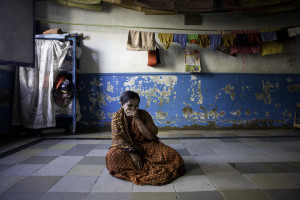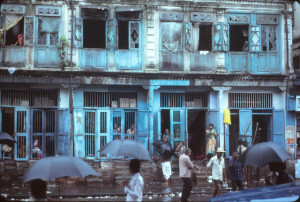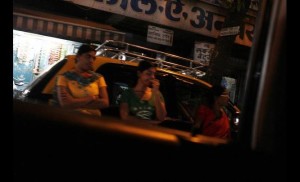Could Not Be Delivered: Can Technology Liberate Mumbai’s Red Light Areas?
Prerana Founders Priti & Pravin Patkar conduct an inquiry into the effects the ‘cell phone revolution’ is having on the lives of victims of the sex trade in Mumbai’s Red Light Areas.

This year Mumbai faced one of the worst summers of the last 50 years or more. Temperatures soared to over 40 degree C and humidity levels reached saturation. But such oppressive weather could not be an excuse for not doing our outreach work. ‘Outreach’ was and continues to remain the backbone of Prerana’s 3 decades old intervention in Mumbai’s red light areas (RLA).
A Prerana outreach was underway at the end of May 2015. The occasion was a message regarding a general health camp. By way of a reminder, four members of Prerana’s outreach team physically visited every brothel in Kamathipura, Falkland Road and Vashi-Turbhe RLAs. Not surprisingly, every woman the team met assured them that they had already received the message and would certainly be present for the health-camp.
What was a little surprising was that over 50% of them mentioned to our team that personally visiting them was hardly necessary. Especially considering the scorching summer heat under which people were reportedly dying of sun stroke. They added that it would have sufficed if our team had reminded them on their cell phones. A compassionate, enlightening and most practical suggestion. We welcomed the idea but we also know that we have several other good reasons for physical outreach.
Use of Cell Phones in Red Light Areas
Over the years, the path-breaking work at Prerana has attracted many scholars, students, and journalists, domestic as well as international, to visit and/or undertake internships at Prerana. This time it was a Fulbright scholar from the US. She wanted to study the use of cell phones among the prostituted women – Had it liberated the women? Had it made them their own bosses and offered independence from pimps and madams?
We shared with her some of our observations and experiences from the ground.
Our office is an open space where the women from the RLAs walk in without any hesitation. One of the women from Falkland Road, Reshma (name changed), age 42, walked in accompanied by her daughter Hena (name changed), age 14, whom we had placed in a distant shelter facility for care, protection and development. Hena had come to spend her summer vacation with her mother. After greetings and some initial pleasantries we asked Reshma if she had a cell phone. She promptly dug in between her breasts and pulled out a basic model – a new piece which would not have costed more than 1000 rupees in the market.
Next we asked her for her number. With some embarrassment but without much hesitation she handed over the phone to us stating she did not know her number but that we could find out for ourselves. Hena had an apologetic smile on her face.
This is a common reality. Most of our women use a basic cell phone model for making and receiving calls and for listening to songs. Listening to popular songs while soliciting for customers is a commonplace observation in the evening hours. A small minority of women also have Chinese manufactured smartphones given to them by their relatively well-off regular customers. But hardly anyone remembers her own 10 digit number.
All women share their number with us but most of these numbers change every third month. Reasons range from efforts to keep away from irate and violent customers, miscreants, police and in some cases, pimps to using the devices as small time mortgage. (The latter draws a parallel with the small possessions of the backward area tribal bonded labor whom we have worked with in the past. We observed that the common possessions like wrist watches, brass cookware, and radio transistors suddenly disappear from their possessions only to find a place in the local money lender’s cupboard.)
About four years ago we had conducted a brief inquiry with our women on how cell phones had changed their lives. Most women had mentioned one distinct benefit. Namely that they did not have to depend upon anyone to write a letter to their families back home and that they did not visit public booths to make calls. Cell phones were particularly important when the women were taken into custody by the police and wanted their brothel keeper or pimp to bail them out. Similarly, while outdoors, they could get in touch with their pimp if the customer acted tough and did not keep to the terms of the contract.
The central questions of our current probe are – Has the widespread possession of cell phones among prostituted women led to a new era of sexual independence? Have the women been liberated from the dehumanizing control of madams and pimps? Have they now become their own bosses? Has possessing a cell phone led to self employment as against slavery?
Once again a parallel with the lower income category outdoor workers like couriers and such other delivery boys, is inevitable. Initially when their employers gave them a brand new cell phone the workers felt proud and flaunted the possession. They soon got disillusioned on realizing that with the device on their body they were under a far greater control and monitoring by their supervisors.
When these questions were put to the prostituted women of the RLAs we work in, most of them concurred that since the cell phones have come in their lives:-
– the control and surveillance exercised over them has become stricter and closer
– they are expected to be at the beck and call of their pimps and intimate partners/fancymen who actually double up as pimps
– if the phone is found engaged for too long their loyalty is suspected, resulting in severe punishment and deprivation.
Who has the Control?
Shanta (name changed), one of our women complained that her fancyman (“intimate partner”) cum pimp now keeps a closer watch on her incoming and outgoing calls and seeks detailed explanation for each of the calls. He wants all those calls to reflect in the cash collection, failing which she suffers humiliation and severe physical violence. On some occasions when she was not well and desperately wanted some sleep she switched off her phone. That enraged her fancy-man/pimp. He rushed to the brothel and beat her black and blue. Shanta observed that the cell phone had compounded her distress.
Renuka, age 36, shared that she had moved out of the brothel with her intimate partner dreaming of a life free of exploitation and hoped to lead a ‘respectful’ life away from prostitution, but it wasn’t so. Her intimate partner never trusted her.
She observed, “He always thought that I would cheat upon him once his back was turned. He came home from work every day and first checked my phone. He wanted to know if anyone had visited me and who all had called me and with whom was I chatting.”
“In a day he would call me 10 times. Initially I thought it was because he missed me but soon realized that it was to keep a tab on me. Whenever he tried reaching me on phone and found my phone busy his first question was to who I was chatting with for so long. As it became unbearable I left him. There was nowhere to go so I returned to the brothel from where he had taken me away. To many I proved the proverb ‘once a randi, always a randi’. No one wants to know the circumstances under which I returned to the trade.”
Online Soliciting
Our next inquiry was on whether and how possessing cell phones has affected street based soliciting. An important aspect of this was the demand of the customer to check the product before buying. Our general experience with ‘online retailing’ of goods supports the view that online customers want to ensure the quality of the goods they are buying (unless of course the products are minutely standardized and known). Hence online retailers are required to display (2D & 3D) images of the goods as well as show to the customers how they would look on wearing those products.
While installation of any apps that would enable the customers to “inspect and thoroughly check” the goods is an indecent idea it is also doubtful if the women who do not remember their own cell number will be technically savvy to use such advanced apps. How many middle class and educated computer users are familiar with even half of the functions and features of something as basic as MS Window or MS Word even after having used computer for years?
Also, there is also no way simple cell phones with just incoming and outgoing call facility could meet such a demand.
Can Technology Put an End to Red Light Areas?
So has the cell phone revolution led to reduction of RLAs? The answer is negative! Although the conventional RLAs have reduced in number, size, and numerical strength it has little to do with cell phones. Mumbai’s RLAs are a product of the British rule that set them up at the port cities and cantonment areas to meet the need of commercial sex generated by its sailors and soldiers. As these RLAs grew in size they started coming in conflict with the civil areas and that among other reasons gave rise to several other RLAs in and around Mumbai. The old RLAs which were closer to the ports are now extremely viable properties in the real estate market. There is continuous pressure from the real estate market to have them vacated for redevelopment purposes.
The number of prostituted women in Kamathipura and its satellite RLAs was once believed to be over a 75000. The 1960 study by Punekar and Rao indicated that the number had reduced to around 60,000. Women have already started moving out to other distant places. Prerana remains in touch with them as we continue to protect their children. Women have also moved out as the customers have moved out due to the ever rising prices of real estate. As the women move out, pimps and madams follow. Some women now live far away but commute daily to the RLAs.
Sex Talk
The last question we asked some of the women was if they used the cell phones for selling ‘sex talk’. Most of them felt hurt. They said they were not required to sell sex talk but were not sure if the next generation of women trafficked into prostitution would have that choice. Speaking for themselves, they said they condemn sex talk. This observation needs further probing.
Can Technology Liberate?
A couple of years ago, a group from Mysore (from the state of Karnataka in India) visited Prerana to understand the ESG (Educational Support Group) model. The group mentioned that they were a part of an effort to develop a cell phone app to assist HIV positive women undergoing treatment by sending timely reminders about their doses. Although we did not get to know about the final outcome of those efforts we have yet to see any of our women in the 3 prominent RLAs of Mumbai use such cell phone apps for their treatment.
It is commonly believed that science and technology are liberating forces. It is true to the extent that they have the potential to reduce the distress and uncertainty in human life. But technology is potentially a double edged sword. Disruptive technology is very much a part of our life. Neither on a priori reasoning nor with field based observation can we conclude that the possession of cell phones by prostituted women has led to their freedom from their exploiters.
The women do not hold the same gadget with the same identity number for too long as they are constantly running away from innumerable sources of violence and control. Even if they have the capacity to handle advanced technology built in their favor they would require considerable training and encouragement. We are living in a state and a civil society that is not yet known by any of these gestures.
The Reality, As of Now
In a world of natural and man-made disasters, where human beings are increasingly becoming vulnerable, markets are uprooting settled human life, families and primary level protective mechanisms are crashing down, where human trafficking is on the rise, where recreation is increasingly described by its commercial inhuman and exploitative qualities there is little scope to believe that pimps and brothel keepers are disappearing or reducing in number.
Technology has also proven itself to be a force that accentuates inequalities. Almost all the street based prostitutes that we work with and that live and operate in the RLAs are at the lowest rung of caste, class and status. They have no collective strength. They are victims of various layers of violence, discrimination, stigma and exclusion. Using apps and harnessing the ‘power’ of technology remains a distant reality.
At Prerana, we may accept the suggestions of our women and send the last minute SMS instead of physically visiting. But the reality of exploitation and captivity is still the prime identity of the sex trade. With or without cell phones.
(pictures courtesy – Jaideep Vaidya, wn.com, Operation Mockingbird)














